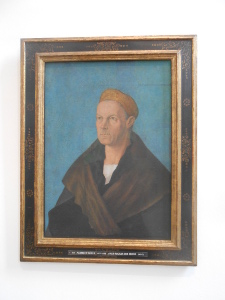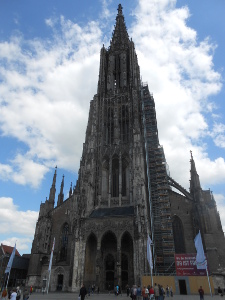 Jakob Fugger
Jakob Fugger Jakob Fugger
Jakob Fugger
We began our Augsburg visit with a trip to the Fugger Walser Museum.
Yes, that Fugger, the one from the fifteenth century who became a trader and then lent money to the Emperor Maximilian of the House of Habsburg. Jacob Fugger was known as Jacob the Rich; he acquired lots of land and mining interests in three places in Europe and traded out of Venice to the Indies. The Walsers were also wealthy traders but they went bankrupt a hundred years later whereas the Fugger family is still in  Door to Private Banking
business, same outfit, nearly 700 years later, engaging in Private Banking in the building next door to our hotel with the beautiful door. Our hotel, Drei Mohren, was snazzy, too, named after four monks from Abysinnia who visited Augsburg in the seventeenth century. Finding the winter harsh, the monks headed south but one of the four died, and an innkeeper rescued them and brought them back to Augsburg, where they recovered. Later he painted a sign with the heads of the three "moors" and hung it outside his inn. The
Door to Private Banking
business, same outfit, nearly 700 years later, engaging in Private Banking in the building next door to our hotel with the beautiful door. Our hotel, Drei Mohren, was snazzy, too, named after four monks from Abysinnia who visited Augsburg in the seventeenth century. Finding the winter harsh, the monks headed south but one of the four died, and an innkeeper rescued them and brought them back to Augsburg, where they recovered. Later he painted a sign with the heads of the three "moors" and hung it outside his inn. The  Drei Mohren
hotel has a green roof with wildflowers and honey bees, too.
Drei Mohren
hotel has a green roof with wildflowers and honey bees, too.
The Fugger Walser Museum was a lot of fun. They handed us a little sack of pepper (because Fugger traded in pepper from the Spice Islands) inside of which was an electronic chip, and we were told to hold the sack up next to certain parts of the museum displays and the speaking would be in English. That was very nice. Also, a number of the exhibits were Then and Now, about how the trading and banking and mining  Green roof and beehives
businesses have changed over the centuries, and they were pretty socially conscious showing videos, for example mining conditions in present day Bolivia. We altogether liked the creativity (such as holographic talking pictures) of this excellent museum and recomment it most highly. It was the first of several times in Germany where significant efforts have been made to engage English speakers.
Green roof and beehives
businesses have changed over the centuries, and they were pretty socially conscious showing videos, for example mining conditions in present day Bolivia. We altogether liked the creativity (such as holographic talking pictures) of this excellent museum and recomment it most highly. It was the first of several times in Germany where significant efforts have been made to engage English speakers.
For lunch we stopped in the central plaza where Elsa had a big plate of spaghetti carbonara which she couldn't eat fully and Bob had a dish of spaghetti ice cream which he could eat fully.
 Hen and Bachelor parties
Hen and Bachelor parties
While having lunch we were entertained by the coming-together of a hen party and a bachelor party (same wedding-to-be, we think). They met in front of McDonald's. The girls all wore distinctive pink t-shirts and the bride-to-be had a white veil over her head, while the guys were all wearing fluorescent green vests except the groom who had on a pink sweatshirt and carried an accordion, which they got him to play after he emerged from McDonald's doing some stunt. He played several tunes and both groups were  Baroque ballroom ceiling
singing and then one of the groomsmen danced with one of the bridesmaids and then they went their separate ways.
Baroque ballroom ceiling
singing and then one of the groomsmen danced with one of the bridesmaids and then they went their separate ways.
The following day was Museum Day, with free admission to most museums in Augsburg. We observed this by a visit to the Schaezler-Palais, featuring the most baroque ballroom in Germany. It was built for Marie Antoinette who visited Augsburg on her way to Paris to marry the man who became Louis XVI. We loved seeing this elegant mansion, including lots of dark paintings by Cranach, Holbein, Hals, Van Dyke, Rembrandt,  Formal garden
Durer, and the like, and a well-kept formal garden on the ground floor. A lot of the paintings were religious, and they weren't displayed very well but still we're glad we visited.
Formal garden
Durer, and the like, and a well-kept formal garden on the ground floor. A lot of the paintings were religious, and they weren't displayed very well but still we're glad we visited.
Making good use of Museum Day, we then took a short train ride to Ulm.
When is a cathedral not a cathedral? The foundation stone for the Ulm Munster was laid in 1377 when the question would not have arisen, but the construction was halted for many reasons: lack of funds, wars,  Tallest minster in Ulm
plagues, and, of course, the Protestant Reformation, when in 1530 the citizens of the city voted to become Lutheran. The architectural features are those of a cathedral, and the spire is the tallest in the world (according to Wikipedia). It is gorgeous, and we were delighted to see that a Lego model of the building, decorations and all, is prominently displayed by the front door.
Tallest minster in Ulm
plagues, and, of course, the Protestant Reformation, when in 1530 the citizens of the city voted to become Lutheran. The architectural features are those of a cathedral, and the spire is the tallest in the world (according to Wikipedia). It is gorgeous, and we were delighted to see that a Lego model of the building, decorations and all, is prominently displayed by the front door.
Over the course of our visit we became aware of the many restoration efforts rebuilding Allied bomb  Lego minster model
damage from the Second World War. These projects make use of skills in carpentry, masonry, textiles, and many other crafts, keeping them alive for new generations, but the extent of the damage and the lingering effects after more than half a century are shocking.
Lego minster model
damage from the Second World War. These projects make use of skills in carpentry, masonry, textiles, and many other crafts, keeping them alive for new generations, but the extent of the damage and the lingering effects after more than half a century are shocking.
Augsburg is a prosperous German city, although not so internationally important as a few centuries ago when 30,000 people worked spinning and weaving cotton and linen to make fustian, a strong, smooth cloth, of which Augsburg was the world manufacturing center.